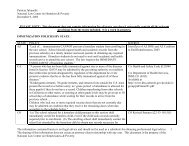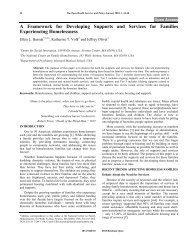A Paradigm shift in Housing and Homeless Services: Applying the ...
A Paradigm shift in Housing and Homeless Services: Applying the ...
A Paradigm shift in Housing and Homeless Services: Applying the ...
You also want an ePaper? Increase the reach of your titles
YUMPU automatically turns print PDFs into web optimized ePapers that Google loves.
Population/High-Risk <strong>Homeless</strong>ness Prevention The Open Health <strong>Services</strong> <strong>and</strong> Policy Journal, 2010, Volume 3 45Table 2.Brief Comparison of Prevention FrameworksPrevention frameworkPrimary/Secondary/Tertiary Prevention Universal/Selected/Indicated Prevention Population/High-Risk PreventionGoalPrevent new <strong>in</strong>dividual cases <strong>and</strong> preventworsen<strong>in</strong>g of condition among casesPrevent cases among <strong>in</strong>dicated <strong>in</strong>dividuals<strong>and</strong> <strong>in</strong> selected populations, <strong>and</strong> prevent<strong>in</strong>cidence <strong>in</strong> <strong>the</strong> general populationPrevent cases among high-riskpopulations <strong>and</strong> prevent <strong>in</strong>cidence <strong>in</strong><strong>the</strong> general populationTemporalityCan be applied to prevent new cases, aswell as to mitigate <strong>the</strong> harm among currentcasesFocuses efforts on prevent<strong>in</strong>g new casesFocuses efforts on prevent<strong>in</strong>g newcasesTarget populationIndividuals with risk factors for <strong>the</strong>condition <strong>and</strong> who currently have or havesuffered from <strong>the</strong> conditionEntire population; high-risk populations;high-risk <strong>in</strong>dividualsEntire population; high-riskpopulationsWhatdist<strong>in</strong>guishes thisframework from<strong>the</strong> o<strong>the</strong>rsFocus is on <strong>the</strong> tim<strong>in</strong>g of <strong>in</strong>terventionsFocus is on <strong>the</strong> target populationFocus is on <strong>the</strong> context <strong>and</strong> causes of<strong>the</strong> preventable conditionuniversal/selected/<strong>in</strong>dicated prevention frameworks addressimportant aspects of prevention, only <strong>the</strong> population/highriskapproach focuses on identify<strong>in</strong>g <strong>and</strong> target<strong>in</strong>g <strong>the</strong> causesof homelessness at multiple levels. It allows us to addressfactors <strong>in</strong> a population that are ubiquitous, such as <strong>the</strong>limited availability of affordable hous<strong>in</strong>g, as well as factorsthat are associated with <strong>in</strong>dividual cases of homelessness,such as substance use. And ra<strong>the</strong>r than focus<strong>in</strong>g on just <strong>the</strong>tim<strong>in</strong>g of prevention (i.e., primary/secondary/tertiaryprevention) or <strong>the</strong> target population for prevention programs(i.e., universal/selected/<strong>in</strong>dicated prevention), thisframework concentrates on identify<strong>in</strong>g <strong>and</strong> elim<strong>in</strong>at<strong>in</strong>g <strong>the</strong>causes of homelessness for society as a whole <strong>and</strong> for <strong>the</strong>most vulnerable subpopulations. Importantly, <strong>the</strong>population/high-risk framework does not imply thatprograms <strong>and</strong> communities must choose between preventionacross <strong>the</strong> population or prevention among high-risk groups.Instead, apply<strong>in</strong>g both prongs of this approachsimultaneously can maximize <strong>the</strong> overall reach <strong>and</strong>effectiveness of prevention programs. The challenge toapply<strong>in</strong>g this prevention approach rests <strong>in</strong> balanc<strong>in</strong>g <strong>the</strong>strengths <strong>and</strong> weaknesses associated with both population<strong>and</strong> high-risk strategies.Population-level prevention strategies face two majorchallenges to prevent<strong>in</strong>g homelessness: (1) ensur<strong>in</strong>g <strong>the</strong>“prevention paradox” does not underm<strong>in</strong>e efforts to preventhomelessness among vulnerable populations; <strong>and</strong> (2)address<strong>in</strong>g <strong>the</strong> challenges associated with <strong>the</strong> political realityof limited resources for prevention efforts. Rose def<strong>in</strong>ed <strong>the</strong>prevention paradox as “a preventive measure which br<strong>in</strong>gsmuch benefit to <strong>the</strong> population [but] offers little to eachparticipat<strong>in</strong>g <strong>in</strong>dividual” [53]. This would occur ifprevention activities are diffused throughout <strong>the</strong> population<strong>in</strong> such a way that <strong>the</strong>y do not do enough to help <strong>the</strong> mostvulnerable <strong>in</strong>dividuals. For example, although <strong>the</strong>fundamental causes of homelessness, such as lack ofaffordable hous<strong>in</strong>g, are relevant to all persons, o<strong>the</strong>r causesmay also be relevant to vulnerable subgroups. It is likelythat, because of <strong>the</strong>ir disabilities, persons with mental illnesswill require both affordable hous<strong>in</strong>g <strong>and</strong> special services <strong>in</strong>order to prevent homelessness or to rema<strong>in</strong> stably housed.The second problem with implement<strong>in</strong>g populationstrategies is that resources for prevent<strong>in</strong>g homelessness arelimited. If spread too th<strong>in</strong>ly across <strong>the</strong> entire population,<strong>the</strong>se strategies may not have a significant or detectableimpact on <strong>the</strong> rate of homelessness. To get results at <strong>the</strong>population level would require a substantial <strong>in</strong>vestment ofcurrently unavailable resources. Given <strong>the</strong> politicalconstra<strong>in</strong>ts which limit resources, high-risk strategies – asopposed to population strategies – could offer a more costeffectiveapproach to prevention by concentrat<strong>in</strong>g resourceswhere <strong>the</strong> need <strong>and</strong> benefit are likely to be greatest [52].High-risk prevention strategies also pose two majorchallenges: (1) challenges that arise with identify<strong>in</strong>g <strong>the</strong>“right” people to whom <strong>in</strong>terventions should be targeted; <strong>and</strong>(2) <strong>the</strong> challenge of distribut<strong>in</strong>g scarce resources to <strong>in</strong>dicatedpeople while hold<strong>in</strong>g <strong>the</strong> overall social environment constant(i.e., <strong>the</strong> challenge of “queue jump<strong>in</strong>g”) [51]). High-riskprevention strategies are predicated on be<strong>in</strong>g able to identifyan appropriate target population based on empiricallyderivedrisk factors of <strong>in</strong>dividual cases of homelessness. Ingeneral, <strong>the</strong> problem of target<strong>in</strong>g is controlled by <strong>the</strong> factthat only a small proportion of <strong>the</strong> general population willever become homeless [5, 6]. Predict<strong>in</strong>g who will fall <strong>in</strong>tothis category is cont<strong>in</strong>gent on multiple, identifiable, <strong>and</strong>unique risk factors, <strong>and</strong> current screen<strong>in</strong>g tests are notsensitive enough to pick up <strong>the</strong> heterogeneous complexitiesassociated with homelessness [51, 54].Recent studies show that our current methods foridentify<strong>in</strong>g who is most likely to experience homelessnesshave been largely <strong>in</strong>sensitive <strong>in</strong> predict<strong>in</strong>g who will becomehomeless <strong>in</strong> <strong>the</strong> future [55, 56]. 3 The evidence suggests thatresources for prevent<strong>in</strong>g homelessness are <strong>in</strong>evitably spenton some households that would not have become homelesseven without <strong>the</strong> <strong>in</strong>tervention—an admirable <strong>and</strong> ethicalexpense, perhaps, but none<strong>the</strong>less not homelessnessprevention. Perhaps more troubl<strong>in</strong>g, an even largerproportion of potential homeless households are missed.3 These are problems with all screen<strong>in</strong>g tests: when <strong>the</strong> sensitivity (i.e., <strong>the</strong>probability of correctly identify<strong>in</strong>g all those who become homeless from aparticular population) of a test <strong>in</strong>creases, <strong>the</strong> specificity (i.e., <strong>the</strong> probabilityof correctly identify<strong>in</strong>g all those who will not become homeless from thatpopulation) will decrease.
















